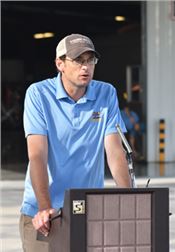|
After Tough Start, Rice Crop Looks Promising
MAMOU, LA.
The Louisiana rice crop is having a challenging year, but good weather in June could result in a decent harvest, according to the LSU AgCenter rice specialist.
“Don’t expect a record yield,” Dustin Harrell said at field day held May 27 near Iowa in Calcasieu Parish.
At a field day on May 30 in Mamou in Evangeline Parish, Harrell said weather extremes have caused several problems. Excessive rainfall flooded fields prematurely.
Wet fields also delayed fertilizer and herbicide applications.
A new product, Anvol, has proven to be effective at preventing nitrogen losses, particularly on acidic soils, Harrell said.
AgCenter rice breeder Adam Famoso said the new Provisia variety, PVL02, has a 10 percent yield advantage over the first Provisia offering, PVL01.
“It should be an improvement over PVL01 as far as ratoon capacity,” he said.
The variety also has better blast disease resistance, and it matures seven days earlier than PVL01.
The new Provisia variety will be available for commercial production next year. This year, seed is being grown to plant 50,000 to 60,000 acres, he said.
AgCenter plant pathologist Don Groth said the Amistar Top fungicide didn’t work as well as hoped last year. He said the product is the only fungicide labeled for a second crop.
More studies are being conducted this year on Amistar Top to determine how its effectiveness may be improved.
It’s likely that the fungicide needs to be applied earlier before the canopy of rice plants is fully developed, he said.
Two new experimental products are being tested. “I’m hoping we get some different modes of action,” Groth said.
AgCenter weed scientist Eric Webster said he’s studying different rates of the Provisia herbicide. It’s possible that a third application of Provisia may be needed.
Some farmers are using herbicides usually applied on soybeans on their rice crop. “From what we’ve seen this year, do not do that,” Webster said.
His studies this year include testing fertilizer mixed with Loyant herbicide and applying the combination in a flooded field surrounded by soybeans. “We don’t know what it will do after it hits the water,” Webster said.
AgCenter soybean specialist Boyd Padgett said 67 percent of the state’s soybean crop is planted compared to 90 percent at the same time last year. The five-year average is 85 percent planted at the end of May.
Soybeans were submerged in some areas of the state that received heavy rainfall. Soybeans at the Dean Lee Research Station near Alexandria were under water for two days, but they survived because the weather was cool and cloudy afterwards, he said.
A new fungicide for Cercospora blight on soybeans is being tested that looks promising, Padgett said.
AgCenter entomologist Blake Wilson said Dermacor seed treatment remains the best option for rice water weevil control, but the product Fortenza also can be effective against weevils. But unlike Dermacor, Fortenza does not have the ability to control stem borers.
Apple snails are becoming more widespread, but they are confined to the Mermentau and Vermilion basins. So far, the pest is more of a problem for crawfish farming than rice, he said.
The snail’s large pink egg masses are toxic.
Stink bugs will become a problem as the rice crop matures, Wilson said. Spraying is recommended when three stink bugs are found in 10 sweeps during the first two weeks, and afterwards 10 stinkbugs per 10 sweeps. ∆

LSU AgCenter entomologist Blake Wilson speaks at the Evangeline Parish rice field day on May 30 in Mamou, Louisiana.
Photo by Bruce Schultz/LSU AgCenter

LSU AgCenter rice breeder Adam Famoso speaks at the Evangeline Parish rice field day on May 30 in Mamou, Louisiana.
Photo by Bruce Schultz/LSU AgCenter
|
|